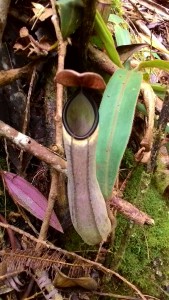By Petrus Kanisius, GPOCP Conservation Awareness and Media Officer

A small pitcher plant, known locally as “kantong semar.” These carnivorous plants are one of Gunung Palung”s many treasures.
“Unimaginable,” maybe that’s the right word for this experience. Truthfully, I couldn’t have imagined I”d have the opportunity to see the array of biodiversity and the beautiful charm of the rainforest in Gunung Palung National Park, but I was able to spend June 2nd-June 10th there earlier this month. At the very least, it was an unforgettable and rare experience to study the spectacular plants and animals. But I should rewind: before it began, my friends and I had to make the long journey into the National Park. Twelve people were invited to attend. With the last of our energy, we finally arrived at about 3:00 pm on June 2nd, after the 8 hour hike into the rainforest. Fatigued and a bit weak, we were happy to now be deep in the National Park, or more accurately, at the Cabang Panti Research Station. We were there to attend a field course, hosted by the National Park office and Dr. Andrew Marshall, of the University of Michigan and the Director of the Red Leaf Monkey and Gibbon research project at Cabang Panti.
“Lucky,” maybe that”s the perfect word to describe it. We were lucky to be here, because not everyone gets an opportunity like this one. We were in the core zone of Gunung Palung National Park, which can only be accessed with special permission from the Park authorities. And we felt lucky, because an experience like this only comes along once in a while. The Cabang Panti Research Station, which was built in 1984, stands on 2,100 hectares of primary rainforest that includes many of the seven ecosystem types found in the Park. These include peat swamp forest, freshwater swamp forest, alluvial forest, and montane forest. The array of ecosystems here provide a good opportunity for researchers to compare the behavior, characteristics, and species of animals and plants found in the various types of forest. And because these ecosystems are all in such close proximity to each other, there is little to no variation in rainfall, seasonality, and latitude.
Over the nine days of the field course, we participated in activities such as animal observation and plant identification. We learned how to distinguish between different types of leaves based on their shape and other features, which was pretty complicated because we had to remember the Latin names of all the species! For example, in the family Dipterocapaceae (the Dipterocarps), the seeds of the trees have wings that enable them to float easily to the ground. We learned to identify many other plant families, including Fabaceae, Myrtales, and Sapindelis, and the best technique to highlight leaf characteristics when taking digital photos, so we could identify unknown species later if necessary.

This tree tag, which reads “GP90,” marks the top of Mt. Palung. The hike from base camp to here is about 4.5 kilometers, and much of the path is very steep. Reaching this point is a true accomplishment!
We also learned how to survey animals in the rainforest, to find animal trails as well as to carry out more formal surveys where we searched along a transect and recorded animal behavior. We saw gibbons, red leaf monkeys, and many birds, but unfortunately we didn”t meet any orangutans in Cabang Panti. Maybe this is because we”re at a low point in the fruit season, so orangutans need to conserve energy and are less likely to travel very far. Aside from the surveys, we learned from both presentations and practical (hands-on) field activities about rainforest ecology, the ecology of various forest vertebrates (birds, reptiles, fish), and the rainforest soundscape. Finally, we also hiked all the way to the top of Gunung Paung. With a height of 900 meters above sea level, this was not an easy journey!
During the last two days of the field course (June 8-9), we did our own research pilot projects. There were 12 of us in the field course, and we were split into four groups. My group compared the abundance of trees with stilt roots in ecosystems close to and further away from the river. Another group researched forest fungi and found more mushrooms at higher altitudes than in the lowlands. The other two groups studied various species of Dipterocarp trees to understand their relationship to the ecosystem. Then, we had to analyze and present our data to the other groups. We learned lots of interesting things and got great advice from Dr. Marshall and Dr. Cam Webb. Endro Setiawan, a botanist and the research manager from the National Park office, also assisted with the field course. In total, 12 of us from five different organizations attended the course. Aside from being an excellent learning experience, the course also helped us network with new colleagues working for conservation in the Gunung Palung landscape. The last day came all too quickly, and I hope that someday soon I have a chance to go back to Cabang Panti.





